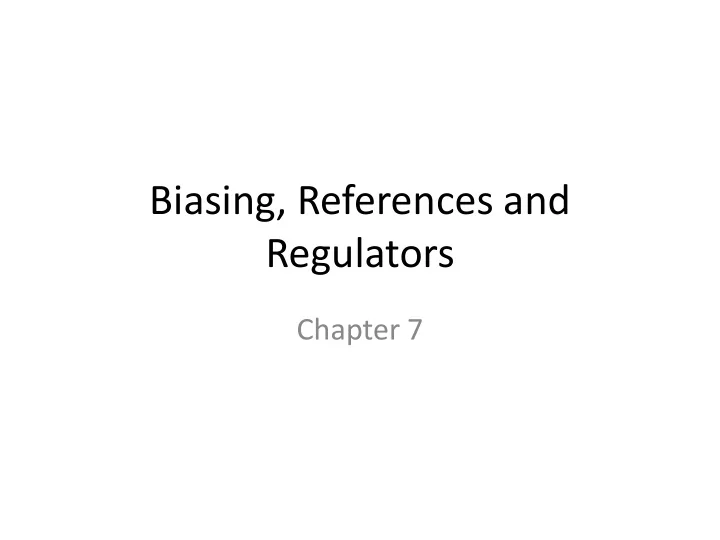

Biasing, References and Regulators Chapter 7
7.1 Analog IC biasing Although often ignored during the course of first-pass analog design, a critical factor in determining a circuit’s overall performance is the quality of DC voltage and current sources. Chapter 7 Figure 01
7.1.1 Biasing circuits Chapter 7 Figure 02 (a) (b) (c)
7.2.1 basic constant-g m circuit As transconductance is probably the most important parameters in an analog amplifier, it needs to be stabilized. An approach proposed by Steininger may be used to stabilize g m independent of power supply, process and temperature variations. Chapter 7 Figure 06
7.2.1 basic constant-gm circuit + + - Chapter 7 Figure 06 May vary from chip-to-chip Please note the positive feedback from common source Q11, to common source Q15. For stability, it requires R B to be large enough so that Q15 has a gain much less than 1.0.
7.2.1 basic constant-g m circuit Body effect plays a role for Q15. Also, channel length modulation affects the circuit as well. Both effects can be mitigated using a modified circuit. Here, Q14/15 become pMOS devices, and body of Q15 is connected to source to eliminate body effect. Furthermore, an amplifier is used to maintain equal voltages at the transistor drain terminals, reducing output impedance effects. In addition to the positive feedback, now OpAmp and Q12/13 form a negative feedback, which may need to be stabilized by compensation capacitor Cc. A fundamental limitation is that at high temperatures, the currents and V eff increases to compensate carrier mobility degradation to keep g m constant, and this may limit signal swing in lower supply voltages. Therefore, V eff is not to be designed too large (0.2-0.25V at T=300k). Chapter 7 Figure 07
7.2.2 Improved constant-g m circuit It is possible to have wide-swing current mirrors to the constant-g m circuit to provide biasing voltages. An example start-up circuit is also given to prevent all current going to 0. If that happens, Q9 is off, Q8 is always on, then gates of Q10/11 pulled low, which then injects currents to the bias loop, which start up the circuit. After that, Q9 on, pull gates of Q10/11 high, turning them off so they do not affect the circuit operation anymore. Chapter 7 Figure 08
7.1.2 Reference circuits
7.3 Establishing constant voltages/currents An important analog building block is a voltage reference. Ideally, this block will supply a fixed DC voltage of known amplitude that does not change with temperature. This can be combined with an accurate resistance to provide a stable DC current. The most popular approach is to cancel the negative temperature dependence of a PN junction with a positive temperature dependence from a PTAT (proportional to absolute temperature) circuit. PTAT is usually realized by amplifying the voltage difference of two forward-biased base-emitter (or Diode) junctions. Voltage references realized this way is called “Bandgap” voltage references. Chapter 7 Figure 09
7.3 Establishing constant voltages/currents
Example 7.3 (page 312)
Example 7.3 (page 312) Junction currents are usually proportional to absolute temperature bandgap
Example 7.3 (page 312)
7.3.2 Circuits for bandpap references Chapter 7 Figure 10
7.3.2 Bipolar bandgap references Chapter 7 Figure 11
CMOS bandgap references npn pnp Chapter 7 Figure 12
Chapter 7 Figure 13
If absolute current is needed, on-chip R needs to be trimmed and temperature- compensated. Off-chip R can be used as well. Chapter 7 Figure 16
7.1.3 Regulator circuits A regulator’s main purpose is to produce a voltage which has low noise and from which some current may be drawn. They are common when a critical analog circuit must operate from the same power supply voltage as other circuits. As other circuits or especially digital circuits introduce significant (called digital switching noise) to the common supply, a regulator can maintain a relatively quite supply for the critical circuit. As digital circuits are major sources of power supply noise, regulators are common in today’s mixed analog -digital IC. The regulated voltage is generally lower than the regulator’s supply voltage. Chapter 7 Figure 05
7.4 Voltage regulation Chapter 7 Figure 17
7.4.1 Specifications
7.4.2 Feedback analysis Chapter 7 Figure 18
7.4.2 Feedback analysis Chapter 7 Figure 18
7.4.3 Low dropout regulators A polarity change Chapter 7 Figure 19
Neglecting C gd of the transistor Chapter 7 Figure 20
PSRR Open loop A(s) = V reg (s)/V DD (s) Then closed loop A f (s) = A(s)/[1+L(s)] = PSRR -1 Chapter 7 Figure 21
Recommend
More recommend